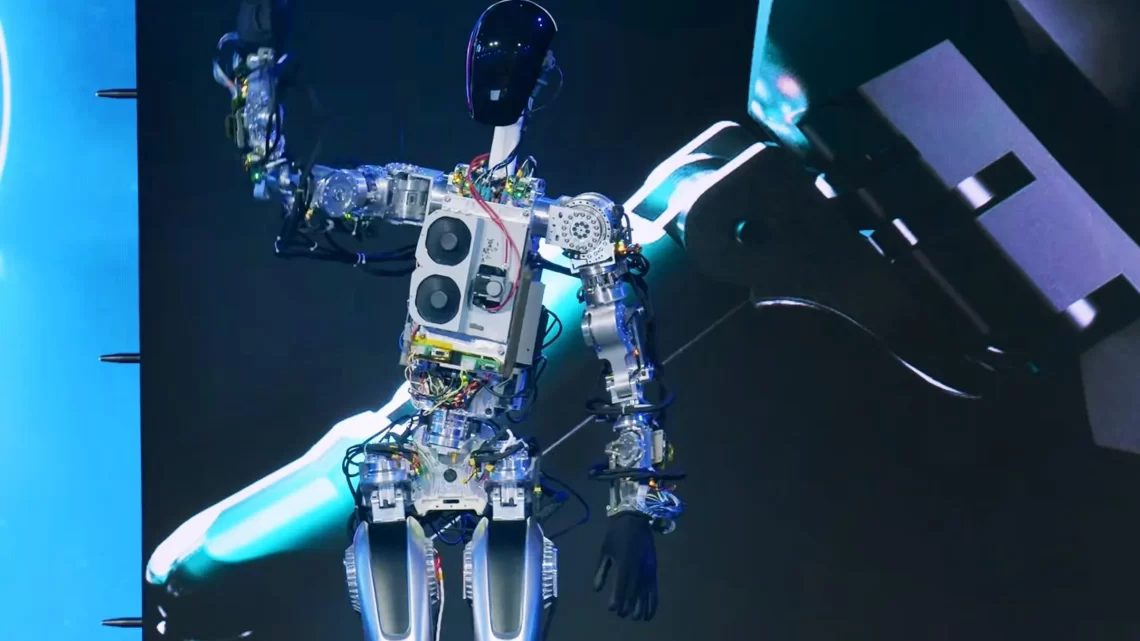
Exploring the Nexus of Robotics and Science: An Introduction to Biorobotics
February 7, 2024I. Introduction to Biorobotics
Introduction to Biorobotics:
Biorobotics is an interdisciplinary field that merges principles from biology, robotics, and engineering to design and develop robots inspired by biological systems. These robots are often referred to as bio-inspired or biomimetic robots, as they mimic the structure, behavior, and functionality of living organisms. The scope of biorobotics encompasses a wide range of applications, including medicine, agriculture, exploration, and environmental monitoring.
Importance of Rooting Robotics Research in Science:
Rooting robotics research in science is crucial for several reasons. Firstly, understanding the underlying biological principles allows researchers to create robots that are more efficient, adaptable, and robust. By studying natural systems, scientists can uncover solutions to complex problems that have evolved over millions of years of natural selection. Additionally, integrating scientific knowledge into robotics research fosters collaboration between disciplines, leading to innovative breakthroughs and advancements. Moreover, grounding robotics in science ensures that the development of robotic technology aligns with ethical and ecological considerations, promoting responsible innovation.
Two Approaches to Robotics Science: Synthetic Science vs. Unveiling Natural Principles:
- Synthetic Science: This approach involves designing robots based on abstract principles and engineering concepts without direct reference to natural systems. Researchers focus on creating robots that achieve specific tasks efficiently, often employing techniques such as mathematical modeling, control theory, and optimization algorithms. While this approach allows for rapid development and customization of robots for practical applications, it may overlook valuable insights from biological systems.
- Unveiling Natural Principles: In contrast, this approach emphasizes the study of biological organisms to uncover fundamental principles that can be applied to robotics. By observing and analyzing the behavior, structure, and functionality of living organisms, researchers gain insights into innovative design principles and mechanisms. Biomimetic robots developed through this approach often exhibit enhanced adaptability, resilience, and efficiency compared to purely synthetic designs. However, implementing natural principles into robotic systems may present challenges in terms of complexity, scalability, and reproducibility.
In summary, biorobotics offers a promising avenue for developing advanced robotic systems by leveraging insights from biology and science. By integrating synthetic science and unveiling natural principles, researchers can create robots that not only perform complex tasks but also emulate the remarkable capabilities of living organisms.
II. Bioinspiration in Robotics:
Bioinspiration in robotics involves drawing inspiration from biological systems to design and develop innovative robots with enhanced capabilities. By mimicking the structure, behavior, and functionality of living organisms, bioinspired robots can overcome challenges and achieve tasks in diverse environments. This approach allows engineers and researchers to harness the efficiency, adaptability, and resilience observed in nature to create novel robotic systems.
Understanding the Role of Bioinspired Machines and Robots:
Bioinspired machines and robots serve as a bridge between biological systems and engineering solutions. They are designed to replicate the remarkable features and behaviors found in nature, offering solutions to complex problems in various fields. By studying and emulating natural mechanisms, bioinspired robots can navigate challenging terrains, manipulate objects with precision, and adapt to changing environmental conditions. Moreover, these robots often provide insights into biological principles and phenomena, contributing to our understanding of living organisms and their interactions with the environment.
Examples of Bioinspired Robotics:
- Gecko-Inspired Climbing Robots: Gecko-inspired robots leverage the unique adhesive properties of gecko feet to climb vertical surfaces with ease. By mimicking the hierarchical structure and nanoscale adhesion mechanisms of gecko toes, these robots can adhere to a wide range of surfaces, including smooth glass and rough walls, without the need for additional adhesives. This bioinspired approach to climbing enables robots to access inaccessible areas for inspection, maintenance, and surveillance applications.
- Lizard-Tail Controlled Robots: Lizards possess remarkable agility and maneuverability, particularly in their ability to detach and regenerate their tails as a defense mechanism. Researchers have developed bioinspired robots that mimic this capability to navigate complex environments and evade obstacles. These robots utilize flexible appendages or tails to facilitate agile locomotion and perform tasks in confined spaces, such as search and rescue missions in disaster scenarios.
- Water Strider Jumping Robots: Water striders are insects known for their ability to move effortlessly across the surface of water using surface tension. Bioinspired jumping robots inspired by water striders exploit similar principles to propel themselves across bodies of water. These robots feature lightweight structures and specialized legs that generate sufficient force to overcome surface tension and achieve long-distance jumps. By emulating the natural locomotion of water striders, these robots offer solutions for aquatic exploration and environmental monitoring applications.
In conclusion, bioinspiration plays a vital role in robotics by enabling the development of robots with superior capabilities and functionalities. Examples such as gecko-inspired climbing robots, lizard-tail controlled robots, and water strider jumping robots demonstrate the diverse applications and potential of bioinspired robotics in addressing real-world challenges across different domains.
III. Scientific Validation in Robotics:
Scientific validation in robotics involves using robots as experimental tools to test and validate scientific hypotheses derived from observations of biological systems. By building robotic models that emulate the behaviors and mechanisms of living organisms, researchers can conduct controlled experiments to verify theoretical principles and gain insights into the underlying biological phenomena. This approach not only advances our understanding of natural systems but also contributes to the development of innovative robotic technologies.
Using Robots to Validate Scientific Hypotheses:
Robots serve as valuable tools for validating scientific hypotheses by providing a platform for controlled experimentation and observation. By replicating specific features or behaviors of biological organisms, robots allow researchers to manipulate variables, conduct repeatable experiments, and collect quantitative data to test hypotheses rigorously. Moreover, robots can simulate real-world conditions and environmental factors, enabling researchers to explore complex interactions and dynamics that may be challenging to study in living organisms directly.
- Salamander Locomotion: Salamanders exhibit a unique mode of locomotion characterized by rhythmic undulations of their bodies, which enable efficient swimming and crawling on land. Researchers have developed robotic models inspired by salamander locomotion to investigate the biomechanics and neural control mechanisms underlying this behavior. By manipulating the parameters of the robotic models and comparing their performance with biological observations, scientists can validate hypotheses regarding the neural circuits and biomechanical principles involved in salamander locomotion.
- Gecko Adhesion: Geckos possess remarkable adhesive capabilities, allowing them to climb vertical surfaces and adhere to ceilings using millions of microscopic hair-like structures called setae. Robotic models inspired by gecko adhesion have been developed to study the underlying principles of adhesion and friction in dry and wet conditions. By varying parameters such as surface roughness and material properties, researchers can validate hypotheses related to the nanoscale adhesion mechanisms and surface interactions involved in gecko-inspired adhesion.
- Lizard Tail Control: Lizards can detach and regenerate their tails as a defense mechanism, exhibiting precise control over the movement and behavior of their tails. Robotic models mimicking lizard tail control have been used to investigate the biomechanics and neural control mechanisms underlying tail autotomy and regeneration. By simulating tail detachment and movement in robotic systems, researchers can validate hypotheses regarding the neuromuscular control and evolutionary advantages of tail autotomy in lizards.
- Water Strider Jumping: Water striders are insects capable of jumping across the surface of water using surface tension to propel themselves. Robotic models inspired by water strider jumping have been developed to study the biomechanics and hydrodynamics of water surface interaction. By replicating the leg morphology and jumping behavior of water striders, researchers can validate hypotheses regarding the role of surface tension and leg propulsion in achieving long-distance jumps on water surfaces.
In summary, using robots to validate scientific hypotheses offers a powerful approach for understanding the principles and mechanisms underlying biological systems. Case studies such as salamander locomotion, gecko adhesion, lizard tail control, and water strider jumping demonstrate the utility of robotics in validating hypotheses derived from observations of natural phenomena, contributing to interdisciplinary research at the intersection of biology and robotics.
IV. Interdisciplinary Research in Biorobotics:
Interdisciplinary research in biorobotics involves the integration of robotics with life sciences, fostering collaborative efforts between engineers and biologists to develop innovative solutions with a wide range of potential applications. By combining expertise from diverse disciplines, interdisciplinary research in biorobotics aims to address complex challenges and explore new frontiers at the intersection of biology and robotics.
Integration of Robotics with Life Sciences:
The integration of robotics with life sciences involves leveraging principles and insights from biology to inspire the design and development of robotic systems. By studying biological organisms and ecosystems, researchers can gain valuable knowledge about adaptive strategies, locomotion mechanisms, sensory perception, and other functionalities that can be replicated or adapted in robotic systems. This interdisciplinary approach enables the creation of bioinspired robots with enhanced capabilities and functionalities, such as agility, resilience, and adaptability, for various applications.
Collaborative Efforts Between Engineers and Biologists:
Collaborative efforts between engineers and biologists are essential for advancing interdisciplinary research in biorobotics. Engineers bring expertise in robotics, mechanical design, control systems, and computational modeling, enabling them to translate biological principles into engineering solutions. Biologists provide insights into the structure, function, and behavior of living organisms, guiding the development of bioinspired robots and validating their performance against biological benchmarks. Through close collaboration and interdisciplinary exchange, engineers and biologists can synergistically combine their knowledge and skills to tackle complex research questions and push the boundaries of biorobotics.
Potential Applications and Implications of Interdisciplinary Research:
Interdisciplinary research in biorobotics holds immense potential for addressing a wide range of societal challenges and exploring novel applications in various domains. Some potential applications and implications of interdisciplinary research in biorobotics include:
- Biomedical Robotics: Biorobotic systems can be used for medical applications, such as minimally invasive surgery, targeted drug delivery, rehabilitation therapy, and prosthetic devices. By integrating robotics with biological knowledge, researchers can develop innovative solutions to improve patient outcomes and enhance healthcare delivery.
- Environmental Monitoring: Biorobots equipped with sensors and actuators can be deployed for environmental monitoring and ecological research. These robots can navigate challenging terrains, collect data on biodiversity, monitor pollution levels, and assess environmental health, contributing to conservation efforts and sustainable resource management.
- Agricultural Robotics: Biorobotic systems can automate agricultural tasks such as planting, harvesting, and pest control, improving efficiency, reducing labor costs, and minimizing environmental impact. By integrating robotics with biological insights, researchers can develop precision agriculture technologies to optimize crop production and enhance food security.
- Exploration and Disaster Response: Biorobots inspired by natural systems can be deployed for exploration missions in extreme environments, such as space exploration, deep-sea exploration, and disaster response. These robots can navigate harsh conditions, gather data in real-time, and perform tasks in inaccessible or hazardous areas, advancing scientific discovery and enhancing disaster preparedness and response capabilities.
In summary, interdisciplinary research in biorobotics offers exciting opportunities to advance knowledge, address societal challenges, and create transformative technologies with far-reaching implications. By integrating robotics with life sciences and fostering collaborative efforts between engineers and biologists, researchers can unlock new insights, develop innovative solutions, and pave the way for a future where bioinspired robots play a vital role in enhancing human well-being and understanding the natural world.
V. Case Studies in Biorobotics
Here are detailed analyses of three seminal papers in biorobotics, discussing their methodologies, findings, implications, and contributions to the scientific foundation of robotics:
- Paper Title: “Dynamic Locomotion of Quadrupedal Robots Inspired by Real Animals”
Methodology: This paper presents a study where researchers analyzed the locomotion of real animals, such as dogs and horses, to derive principles for the design of quadrupedal robots. They developed a bioinspired control algorithm based on the coordination of limb movements observed in animals. The researchers implemented this algorithm on a quadrupedal robot and conducted experiments to validate its effectiveness in achieving dynamic and agile locomotion.
Findings: The study demonstrated that by mimicking the coordination patterns observed in real animals, the quadrupedal robot could achieve stable and efficient locomotion across various terrains. The bioinspired control algorithm enabled the robot to dynamically adjust its gait and posture in response to changes in terrain conditions, resulting in improved stability and adaptability.
Implications: This research has significant implications for the design of legged robots capable of traversing challenging environments with agility and efficiency. By integrating principles derived from real animals, such as dynamic stability and adaptive locomotion, into robotic systems, researchers can develop robots with enhanced mobility and versatility for applications in exploration, search and rescue, and disaster response.
Contribution to Robotics: This paper contributes to the scientific foundation of robotics by demonstrating the effectiveness of bioinspired approaches for improving the locomotion capabilities of legged robots. By studying and replicating the dynamic locomotion behaviors observed in real animals, researchers can advance the development of agile and robust robotic systems capable of navigating complex terrains.
- Paper Title: “Bioinspired Soft Robotics for Healthcare Applications”
Methodology: This paper explores the design and development of soft robotic systems inspired by biological organisms, such as octopuses and worms, for healthcare applications. The researchers employ soft materials and compliant structures to mimic the flexibility and adaptability of biological tissues. They demonstrate the feasibility of soft robotics for applications such as minimally invasive surgery, rehabilitation therapy, and assistive devices for individuals with disabilities.
Findings: The study showcases the potential of soft robotics to address challenges in healthcare, including improved patient outcomes, reduced tissue damage, and enhanced patient comfort. Soft robotic devices can conform to complex anatomical structures, navigate confined spaces within the body, and interact safely with delicate tissues, making them suitable for minimally invasive procedures and personalized medical treatments.
Implications: This research has profound implications for healthcare by introducing innovative solutions for medical diagnosis, treatment, and rehabilitation. Soft robotic devices offer advantages over traditional rigid instruments, such as increased dexterity, reduced invasiveness, and enhanced patient compliance, paving the way for advancements in minimally invasive surgery and patient care.
Contribution to Robotics: This paper contributes to the scientific foundation of robotics by highlighting the potential of soft robotics to address critical challenges in healthcare. By drawing inspiration from biological systems and leveraging soft materials and compliant structures, researchers can develop next-generation medical devices and assistive technologies with improved safety, efficacy, and patient comfort.
- Paper Title: “Neuromorphic Engineering: From Biological Inspiration to Implementation of Adaptive Circuits”
Methodology: This paper explores the field of neuromorphic engineering, which aims to design artificial neural circuits inspired by the structure and function of the brain. The researchers investigate biological neural systems to derive principles for building adaptive and efficient computing architectures. They develop neuromorphic hardware platforms capable of emulating neural processing, learning, and adaptation in real-time.
Findings: The study demonstrates the feasibility of neuromorphic engineering for implementing cognitive functions and adaptive behaviors in artificial systems. Neuromorphic hardware platforms can mimic the parallelism, plasticity, and energy efficiency of biological brains, enabling applications such as pattern recognition, sensorimotor control, and autonomous decision-making in robotic systems.
Implications: This research has broad implications for robotics and artificial intelligence by offering novel approaches to hardware design and computing architecture. Neuromorphic systems can bridge the gap between biological and artificial intelligence, enabling robots to learn from experience, adapt to changing environments, and exhibit human-like cognitive capabilities.
Contribution to Robotics: This paper contributes to the scientific foundation of robotics by advancing our understanding of neuromorphic engineering and its applications in adaptive robotics. By emulating the principles of biological neural systems, researchers can develop robotic systems with enhanced cognitive abilities, autonomy, and robustness, paving the way for intelligent machines capable of interacting seamlessly with the real world.
In summary, these seminal papers in biorobotics showcase the diverse methodologies, findings, and implications of interdisciplinary research at the intersection of biology and robotics. By drawing inspiration from biological systems and integrating principles from diverse disciplines, researchers can develop innovative solutions with far-reaching implications for robotics and related fields.
VI. Future Directions and Challenges in Biorobotics:
Biorobotics research is rapidly evolving, driven by emerging trends, ethical considerations, and opportunities for interdisciplinary collaboration. As the field continues to expand, it faces both exciting opportunities and significant challenges that shape its future trajectory.
Emerging Trends in Biorobotics Research:
- Soft Robotics: The development of soft robotics, inspired by the flexibility and adaptability of biological organisms, is a prominent trend in biorobotics research. Soft robots made from compliant materials exhibit enhanced dexterity and safety, enabling interactions with delicate environments and living organisms.
- Biohybrid Systems: Biohybrid systems, which combine living tissues or cells with synthetic components, are gaining attention for their potential applications in medicine, biotechnology, and environmental monitoring. These systems integrate biological sensing, actuation, or energy generation with robotic platforms, opening up new possibilities for regenerative medicine, tissue engineering, and bioenergy production.
- Swarm Robotics: Inspired by collective behaviors observed in social insects and animal groups, swarm robotics focuses on coordinating large numbers of simple robots to perform complex tasks collaboratively. Swarm robotics has applications in search and rescue, environmental monitoring, and distributed sensing, where robustness, scalability, and adaptability are essential.
- Neuro-Robotics: The intersection of neuroscience and robotics, known as neuro-robotics, aims to understand and replicate the principles of neural control and learning in robotic systems. By integrating computational models of the brain with robotic platforms, neuro-robotics offers insights into cognitive processes, motor control, and artificial intelligence.
Ethical Considerations and Societal Impacts:
As biorobotics technologies advance, ethical considerations and societal impacts become increasingly important. Key issues include:
- Privacy and Surveillance: The deployment of robotic systems for surveillance and monitoring raises concerns about privacy infringement and data security. Regulations and guidelines are needed to ensure responsible use and mitigate potential risks to individual privacy.
- Job Displacement: Automation and robotics have the potential to disrupt labor markets and lead to job displacement in certain industries. Strategies for workforce retraining and economic transition are necessary to mitigate the social and economic impacts of automation.
- Ethical Treatment of Animals: Bioinspired robots that replicate animal behaviors or use biological components raise ethical questions about the treatment of animals and the potential for harm or exploitation. Ethical guidelines and oversight mechanisms are essential to ensure the humane treatment of animals in research and development.
Opportunities for Further Interdisciplinary Collaboration and Innovation:
To address the challenges and capitalize on the opportunities in biorobotics, interdisciplinary collaboration is essential. Key areas for collaboration include:
- Bridging the Gap Between Biology and Engineering: Collaborations between biologists and engineers can facilitate the translation of biological principles into robotic systems and vice versa. Interdisciplinary training programs and research initiatives can foster communication and collaboration between researchers from different disciplines.
- Integrating Ethical and Social Perspectives: Ethicists, policymakers, and social scientists play a crucial role in shaping the ethical and societal implications of biorobotics. Interdisciplinary dialogues and stakeholder engagement can inform ethical guidelines, regulatory frameworks, and public perceptions of biorobotics technologies.
- Engaging Diverse Stakeholders: Collaboration with industry partners, government agencies, non-profit organizations, and community stakeholders can accelerate the translation of biorobotics research into real-world applications. Interdisciplinary partnerships can facilitate technology transfer, funding opportunities, and knowledge exchange to address societal needs and priorities.
In conclusion, the future of biorobotics is characterized by emerging trends, ethical considerations, and opportunities for interdisciplinary collaboration and innovation. By addressing these challenges and working together across disciplines and sectors, researchers can unlock the full potential of biorobotics to advance science, improve human well-being, and contribute to a sustainable future.
VII. Conclusion:
In conclusion, our exploration of biorobotics has provided insights into a fascinating interdisciplinary field that merges principles from biology, robotics, and engineering. We’ve discussed key concepts, including bioinspiration in robotics, scientific validation, interdisciplinary research, and future directions. Here’s a recap of the key concepts and insights gained:
- Bioinspiration in Robotics: We’ve seen how researchers draw inspiration from biological systems to design and develop innovative robots with enhanced capabilities. Examples such as gecko-inspired climbing robots and water strider jumping robots demonstrate the potential of bioinspired robotics in addressing real-world challenges.
- Scientific Validation: Robots serve as experimental tools to test and validate scientific hypotheses derived from observations of biological systems. Case studies such as salamander locomotion and gecko adhesion highlight the importance of robotics in advancing our understanding of natural phenomena and contributing to the scientific foundation of robotics.
- Interdisciplinary Research: Collaboration between engineers and biologists is essential for advancing interdisciplinary research in biorobotics. By integrating robotics with life sciences, researchers can develop transformative technologies with applications in medicine, agriculture, exploration, and disaster response.
- Future Directions and Challenges: Emerging trends in biorobotics research, such as soft robotics, biohybrid systems, swarm robotics, and neuro-robotics, offer exciting opportunities for innovation. However, ethical considerations and societal impacts must be carefully addressed to ensure responsible development and deployment of biorobotics technologies.
Reflecting on the significance of biorobotics, it becomes evident that this field plays a crucial role in advancing scientific understanding and technological innovation. By studying and emulating biological systems, researchers can create robots that are not only efficient and adaptive but also environmentally friendly and ethically sound. Biorobotics offers promising solutions to pressing societal challenges and opens up new frontiers for exploration and discovery. As interdisciplinary collaboration continues to flourish, biorobotics will undoubtedly contribute to shaping a future where robots coexist harmoniously with humans and the natural world, driving progress and improving quality of life for generations to come.


















